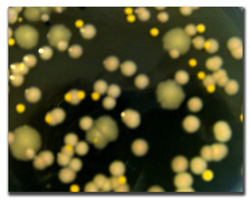USP <61> Microbial Examination of Nonsterile Products
Get A Testing Quote
The US Pharmacopeial Convention (USP) has developed and maintains a compendium of several test methods, which are utilized by companies that produce drugs and cosmetics to ensure quality and product integrity. Individual chapters of the compendium – each detailing a different test method – are identified by the chapter number within carats. For instance, USP <51> is chapter 51, which covers preservative effectiveness testing.
USP <61> is the chapter that describes microbial examination of nonsterile products. The method can be used to assess the microbiological quality of everything from face lotion to a diagnostic reagent. At its core, USP <61> is a well-controlled aerobic plate count assay that includes a complete neutralization and recovery analysis.
Substantial changes to the historical USP <61> test method were made recently, separating the “aerobic plate count” portion of the test from microbial identifications and tests for specific organisms.
Note: Microchem Laboratory is a GLP, not GMP compliant facility. Thus, we do not perform USP 61 tests for the purposes of lot release for drug products.
Summary of the USP <61> Microbial Limits Test
- A nonsterile drug, cosmetic, or diagnotistic reagent is selected for testing.
- Several pure cultures are grown in the laboratory, of a known titer.
- The known cultures are inoculated into the test sample at relatively low concentrations, then the sample is analyzed as normal. This step is called the neutralization and recovery analysis and is key to the integrity of the test.
- To test the sample, an aliquot is dissolved in phosphate buffer. Additional media containing emulsifying agents, neutralizing agents or surfactants may also be used as appropriate.
- One milliliter of the suspension is plated over agar plates and incubated.
- Microbial colonies are counted, dilutions are accounted for, then the microbial concentration within the sample is expressed as either Colony Forming Units (CFU)/g or CFU/ml of test sample.

Strengths of the USP <61> Test
- The method is accepted by FDA for drugs, diagnostic reagents, and cosmetics.
- The method is versatile, so it can be used to assess microbial concentrations across a broad array of sample types.
- The method includes several controls which, if done properly, guarantee that the results of the test are reliable. For instance, the method accounts for the effect of low-level antimicrobial substances in the sample, which may inhibit detection of microorganisms on agar plates.
- The test is relatively simple and straightforward, which means that variability between scientists and laboratories is limited.
Weaknesses of the USP <61> Test
- The techniques described within the method are not always suitable for solid or oil-based samples.
- The method is not always economical nor practical for simple-to-neutralize cosmetic products, since those products are often not very antimicrobial and since they are not subject to the same level of regulatory scrutiny.
- The method does not describe techniques that can be used to enhance detection sensitivity, such as membrane filtration.
- The method does not specify neutralizing agents for various antimicrobial agents, so laboratories must be well versed in product neutralization to ensure successful studies.
Microchem Laboratory is pleased to offer USP <61> testing as a part of its service portfolio, and as a complement to our USP <51> testing service.
